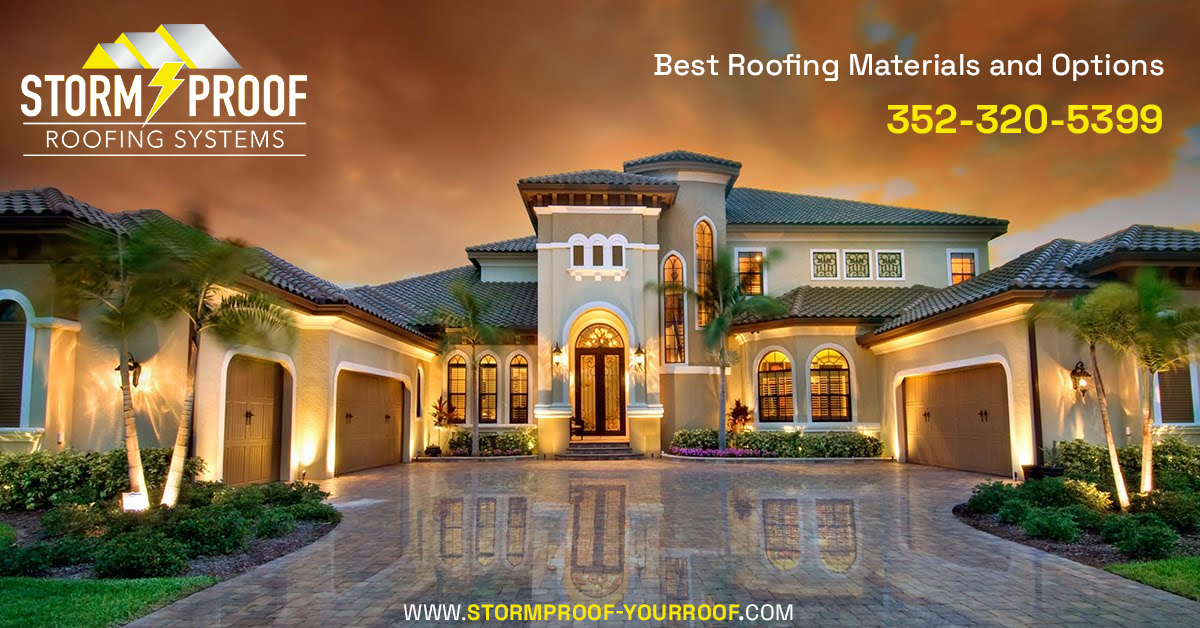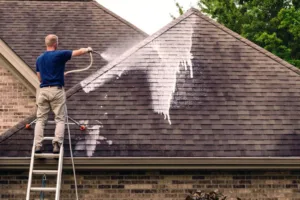Beyond the Storm: A Comprehensive Guide to Choosing the Best Roofing Materials and Options for Ultimate Protection
Introduction
When it comes to building or renovating a house, one of the most crucial decisions you need to make is choosing the right roofing material. The roof is one of the most important parts of your home as it protects you and your family from the elements. However, with natural disasters such as hurricanes, tornadoes, and severe storms becoming more frequent, homeowners must take extra care in selecting a roofing material that can withstand these extreme weather conditions.
The Importance of Choosing the Right Roofing Material for Storm-Proofing
Choosing the right roofing material can mean the difference between a safe and secure home or costly repairs and devastating damage. Storms can cause wind uplift and intense pressure on roofs leading to leaks, structural damage or even complete collapse. It’s important to consider factors like wind-resistance rating, impact resistance rating among others when choosing materials that will hold up under extreme weather conditions.
Another factor that should guide your decision while choosing roofing materials is your geographical location. For those who live in areas prone to hurricanes or tornadoes with high wind speeds, it is essential to choose a storm-resistant roof system that has been tested against high winds and flying debris.
Brief Overview of Different Types of Roofing Materials Available
There are several types of roofing materials available in the market today each with its unique set of pros and cons. The most common types include asphalt shingles, metal roofing, clay tiles and slate tiles among others. Asphalt shingles are popular due to their affordability; they come in different grades and colors making them ideal for various home designs.
They are easy to install but have lower wind resistance ratings compared to other options. Metal roofs offer durability unmatched by any other type of roof covering while providing excellent protection against fire hazards too.
Metal roofs can be made from aluminum,zinc,copper or steel panels which come pre-painted or coated to provide better aesthetic appeal. They are also lightweight making installation easier and reduce stress on the building’s structure.
Clay tiles offer a traditional and aesthetically pleasing option for storm-proofing. They are relatively expensive but they have excellent durability characteristics, making them ideal for extreme weather conditions.
However, they are heavy, which may require extra support to be added to the roof’s structure. Slate tiles provide a high-end option for storm-proofing with a long lifespan of over 100 years.
They come in different sizes and colors, providing versatility in design options. However, slate roofing is expensive and requires specialized installation which increases costs.
Choosing the right roofing material is critical when protecting your home from severe weather conditions that are becoming more frequent due to climate change. By understanding the pros and cons of each material type available and working with a qualified roofing contractor, homeowners can make informed decisions regarding their roof system that will protect their family from whatever nature throws their way.
Asphalt Shingles
The Most Popular Roofing Material in North America
Asphalt shingles are the most popular roofing material for both residential and commercial buildings across North America. There are several reasons why they are so popular: they are affordable, easy to install, and come in a wide range of colors and styles. Their popularity also means that there is a large variety of asphalt shingles available on the market, each with their own advantages and disadvantages.
Pros and Cons of Using Asphalt Shingles for Storm-Proofing
Asphalt shingles can be a good option when it comes to storm-proofing your home or building. They are relatively durable and can withstand moderate winds, hail, and other weather events. However, they have some limitations when it comes to extreme weather conditions like hurricanes or heavy snowfall.
One of the main advantages of asphalt shingles is their affordability. Compared to other roofing materials like metal or slate tiles, asphalt shingles are much more budget-friendly.
Additionally, they can be installed quickly and easily by a professional roofer. However, despite their popularity and affordability, asphalt shingles do have some drawbacks when it comes to storm-proofing.
They have a shorter lifespan compared to other materials like metal roofing or clay tiles, meaning that they may need to be replaced sooner. Additionally, if not properly maintained or installed correctly with adequate ventilation systems in place, asphalt shingles may become damaged over time due to moisture buildup.
Different Types of Asphalt Shingles Available
There are several different types of asphalt shingles available on the market today: – 3-tab shingles: These are the most basic type of asphalt shingle available.
– Architectural (or dimensional) shingles: These offer a more textured look than 3-tab shingles. – Impact-resistant shingles: These are designed to withstand hail and other types of impact damage.
– Solar-reflective shingles: These are coated with special pigments that reflect sunlight, helping to reduce cooling costs. When selecting the type of asphalt shingle for your roofing project, it is important to consider the specific needs and requirements of your building.
For example, if you live in an area prone to hailstorms, you may want to opt for impact-resistant shingles. Alternatively, if you are looking for a more energy-efficient option, solar-reflective shingles may be a better choice.
Metal Roofing
The Versatile Choice for Storm-Proofing Your Home
Metal roofing is a popular option for those looking for a durable and long-lasting solution to protect their homes against storm damage. Not only is it resistant to wind, hail, and fire, but it also has a longer lifespan compared to other roofing materials.
Metal roofing can last up to 50 years or more with minimal maintenance. Its durability makes it an excellent choice for those who live in areas prone to extreme weather.
One of the significant benefits of metal roofing is its versatility. It comes in different styles, colors, and finishes that can match the architecture of any home.
The most common types of metal roofing are steel, aluminum, copper, and zinc. Each type has unique characteristics that make it suitable for specific climates or aesthetics.
Pros and Cons of Using Metal Roofing
Like any other roofing material, metal roofing has its pros and cons that homeowners should consider before making a decision. One significant advantage is its durability; metal roofs can withstand extreme weather conditions such as high winds, heavy rainfalls or even hailstorms without much damage.
Another benefit is its low maintenance requirement; unlike asphalt shingles or clay tiles that need regular cleaning and inspection to prevent damage from moisture buildup or debris accumulation on top of them, metal roofs require little upkeep if properly installed. However, one disadvantage of using metal roofs is the installation cost; they are more expensive than other materials such as asphalt shingles or rubber membranes but are worth the investment in the long run due to their durability and longevity.
Different Types of Metal Roofing Available
There are various types of metal roofing available depending on your needs and preferences. Steel roof panels are cost-effective options that come in different thicknesses depending on how durable they need to be; thicker panels have better resistance to impact. Aluminum roofing panels are ideal for coastal regions as they don’t rust and can withstand saltwater corrosion.
Copper roofing is expensive but offers a luxurious look and can last up to 100 years or more with proper maintenance. Zinc roofing is a lightweight material that can last up to 80 years but requires specialized installation techniques.
Metal roofing is an excellent choice for homeowners looking for a durable, versatile, and long-lasting option that can withstand extreme weather conditions while still providing an aesthetic appeal to their homes. However, it’s important to weigh the pros and cons carefully before making a decision, as well as selecting the right type of metal roofing that fits your specific needs and budget.
Clay Tiles: A Classic and Aesthetically Pleasing Option for Storm-Proofing
Clay tiles have been used as a roofing material for centuries, and for good reason. They are known for their classic and timeless appearance, which can add significant value to any home.
These tiles are made from natural clay that is molded into a tile shape and baked in a kiln to harden them. Clay tiles are available in a variety of colors, shapes, sizes, and textures to suit different architectural styles.
Pros of Using Clay Tiles
One of the main advantages of using clay tiles as a roofing material is their durability. They can last up to 100 years with proper maintenance, making them one of the longest-lasting roofing materials available. Clay tiles are also fire-resistant and energy-efficient since they naturally insulate the roof from heat.
Another pro is that clay tiles are resistant to strong winds and storms when installed correctly. The interlocking design of these tiles creates a sturdy barrier against high winds that might try to lift or tear off the roof’s surface during extreme weather events.
Cons of Using Clay Tiles
The main drawback of clay tile roofing is its weight. These tiles can be quite heavy, which means that not all homes or commercial buildings can accommodate them without additional structural support being installed first.
Additionally, installation costs tend to be higher than other types of roofing materials due to the extra labor required. Another con is that clay tiles are not suitable for all climates or regions with frequent hailstorms because they can crack if hit by large pieces of hail.
Different Types of Clay Tiles Available
There are several types of clay tiles available on the market today: – Spanish style: These flat interlocking tiles have curved edges on one side and straight edges on the other.
– Mission style: Similar in shape to Spanish tiles but with a curved barrel-like profile. – French style: These tiles have a curved shape with a concave center section.
– Italian style: Similar in shape to French tiles but with a convex center section. Clay tiles are an excellent choice for homeowners who want durable and long-lasting roofing material that also looks aesthetically pleasing.
However, they may not be suitable for all homes or regions due to their weight and vulnerability to hail damage. Before choosing the right roofing material for your home, it’s essential to weigh the pros and cons of each option carefully, taking into account your location, climate, budget, and personal preferences.
The Beauty and Durability of Slate Tiles
Slate roofing is a high-end option that provides durable and long-lasting protection for your home. The natural stone material used in slate tiles makes them resistant to severe weather conditions, including storms, hail, and strong winds. Slate tiles are an excellent storm-proofing option because they can withstand high winds gusts up to 200 mph. They are also fire-resistant, making them a safe option for areas prone to wildfires.
Pros of Using Slate Tiles for Storm-Proofing
One significant advantage of using slate tiles is their lifespan. With proper installation and maintenance, slate roofs can last over 100 years, far longer than any other roofing material.
Additionally, slate tiles come in a range of colors and textures to enhance the aesthetic appeal of your home. Another pro is the energy-efficient properties of slate roofing.
Due to its thermal mass quality, heat is absorbed during the day and then released gradually at night when it’s cooler outside. This feature helps regulate temperature inside the house during extreme weather conditions such as heat waves or cold snaps.
Cons of Using Slate Tiles for Storm-Proofing
However, there are some downsides to using slate tiles as well. One significant drawback is the high cost associated with installation compared to other roofing materials like asphalt shingles or metal roofs.
Moreover, because it’s natural stone material from quarries all over the world – transportation costs are higher too due to its weight and size requirements during shipping. Another potential issue with installing a slate roof may be finding a roofer experienced enough in working with this delicate material due to its heavy weight per tile requiring special equipment and technique during installation.
Different Types Of Slate Tiles Available
Although grey/black hues are most common & popular due to their classic look; there are many varieties available in color and texture. The process of choosing the right type of slate for your home is an important step in ensuring your roof is storm-proof for years to come.
Some popular options include: – Welsh Slate: One of the most popular options due to its durability, density, and aesthetic appeal with a blue-grey color.
– Spanish Slate: Known for its deep blue-black color and excellent quality, this option is one of the most durable types available. – Chinese Slate: A budget-friendly alternative with a light grey hue and lower density, thus less durable than other types available.
Slate tiles are an excellent option for homeowners who want high-end, low maintenance roofing that can withstand severe weather conditions. With its long lifespan, energy-efficiency & stunning aesthetic appeal – it’s no wonder why this material has been used as a roofing option for over 1000 years!
Rubber Membrane Roofing
When it comes to flat roofs, a popular and eco-friendly option is rubber membrane roofing. Made from synthetic rubber, this material is designed to withstand harsh weather conditions, making it an ideal choice for storm-proofing your roof. Rubber membrane roofing is also known for its durability and flexibility, enabling it to accommodate structural movements without cracking or tearing.
Pros and Cons of Rubber Membrane Roofing
One of the main advantages of rubber membrane roofing is its high resistance to water, making it an excellent choice for flat roofs that are prone to ponding water. In addition, this roofing material typically lasts between 30-50 years with proper installation and maintenance. Rubber membrane roofing is also very lightweight and easy to install compared to other types of roofing materials.
However, there are some drawbacks associated with rubber membrane roofing as well. One common issue that homeowners have reported is the potential for punctures or tears in the material over time.
This can occur due to a variety of factors such as foot traffic on the roof or falling debris during storms. Additionally, while rubber membrane roofing may be more affordable than some other options initially,in some cases,it can be more expensive in the long run due to repair costs or replacement.
Different Types Of Rubber Membrane Roofings Available
There are two primary types of rubber membrane roofing: EPDM (ethylene propylene diene monomer)and TPO (thermoplastic olefin). EPDM has been used for decades in commercial and residential applications because of its high durability and resistance against weathering.Also one major advantage with EPDM membranes is that they require very little maintenance.However,it can develop leaks at seams .On the other hand,TPO being a newer option has better seam strength than EPDM.
TPO is also said to be more energy efficient (reflecting sunlight instead of absorbing it) than EPDM but its performance during cold temperatures is still under debate because extreme cold weather can make it brittle and difficult to work with. Overall, rubber membrane roofing can be an excellent choice for homeowners looking to storm-proof their flat roofs.
While it may have some disadvantages, the benefits outweigh them in most cases. By choosing the right type of rubber membrane roofing and having it installed by a professional roofer, you can ensure that your home is protected from severe weather conditions while also enjoying long-lasting durability and flexibility.
Storm Proof Roofing Systems
The Importance of Underlayment for Storm Proofing
When it comes to storm-proofing your roof, underlayment is a crucial component that should not be overlooked. Underlayment serves as an extra layer of protection against water infiltration and can help prevent damage to your home in the event of a severe storm. There are several types of underlayment options available, each with its own set of advantages and disadvantages.
One popular type of underlayment is synthetic underlayment. Synthetic underlayment is lightweight, easy to install, and provides excellent moisture protection.
It is also more puncture-resistant than traditional felt paper but can be more expensive. Another option is traditional felt paper, which has been used for many years.
Felt paper is heavier than synthetic underlayment but less expensive. However, it is not as durable as synthetic underlayment and may tear more easily during installation.
Other Storm-Proof Roofing System Options
Aside from the roofing material itself and the underlayment, there are other storm-proof roofing system options you can consider to further protect your home during severe weather events. One option is installing impact-resistant shingles or panels.
These materials are designed to withstand high winds and hail damage without cracking or breaking. They are typically made from a combination of asphalt and fiberglass or metal.
You can also opt for a roof-mounted wind turbine system that can help reduce the amount of wind pressure on your roof during a storm. This innovative technology works by creating negative pressure on the windward side of your roof while simultaneously pulling air through vents on the leeward side.
Conclusion
Choosing the right roofing material and storm-proof roofing system can help protect your home against severe weather events like hurricanes, heavy rainstorms, and hailstorms. When selecting a roofing material, it’s essential to consider factors like durability, cost, and aesthetic appeal.
Additionally, installing high-quality underlayment and other storm-proof roofing system options can provide extra protection against moisture infiltration and wind damage. With the right combination of materials and systems in place, you can have peace of mind knowing that your home is well-protected no matter what Mother Nature throws its way.



